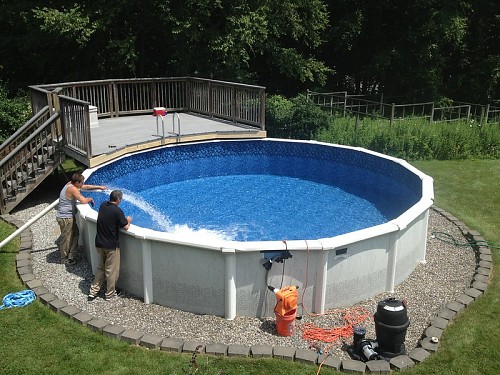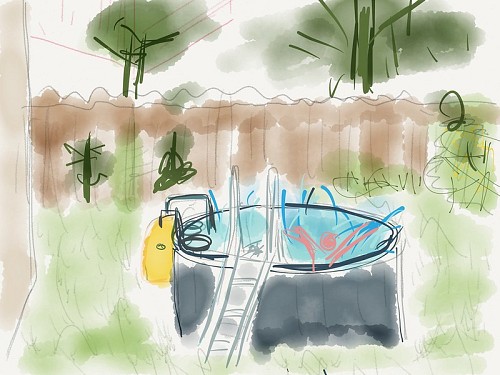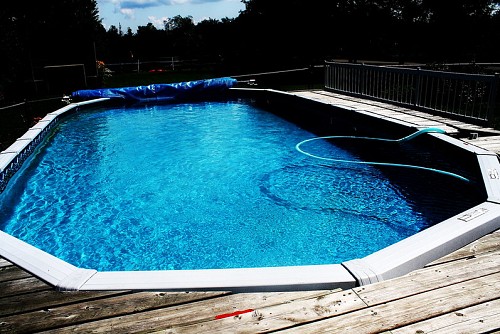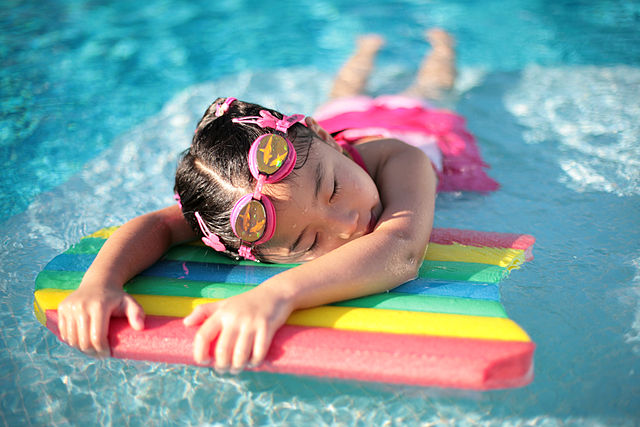10 Tips That Will Make The Most Of Your Aboveground Pool
 Welcome summer! Like most of us, your summer plans probably involve a stay-cation at home. Installing an above ground pool is an affordable way to add excitement to your back yard. Get the maximum from your new pool with these 10 tips.
Welcome summer! Like most of us, your summer plans probably involve a stay-cation at home. Installing an above ground pool is an affordable way to add excitement to your back yard. Get the maximum from your new pool with these 10 tips.
- Pull a permit. Many municipalities require a residential building permit for aboveground pool installation, especially if it is over18 inches deep. You might even need two permits – one for the pool itself, plus an electrical permit if you’re installing an electric filter, pump, or heater – and possibly an inspection as well. Whew!
- Increase your homeowners insurance. Have a talk with your provider about how much additional homeowners insurance you’ll be needing. Experts recommend liability coverage of at least $500K when you have an aboveground pool on your property.

- Build a fence. You’ll have to build a safety fence around your pool when the water measures at least 18-24 inches deep, depending on where your home is located. Usually the law specifies a minimum fence height of 4 feet on the outer side – though taller fencing is often required.
- Prep your location. First, get rid of rocks and level the soil, digging out high areas rather than building up low ones. (This important step keeps the pool wall from sagging or falling.) Remove all sod; otherwise, the grass will damage your pool as it rots. Then add a layer of pool sand or stone dust.
- Get some help – a lot of help. Find a team of muscular friends to help you with the actual setup – aboveground pool walls are heavy! Better yet, hire a handyman crew. When’s the best time to install your new swimming pool? A warm sunny day will make the liner flexible and much easier to stretch into place.

- Shock your aboveground pool regularly. As soon as you fill the completed pool for the first time, dose it with a chlorine shock, which will disinfect and prevent the growth of algae and bacteria. Continue to shock regularly at least once a week, and more often when: a) the pool has been used a lot, B) you’ve just had a storm, or C) you happen to notice that the water is murky and/or greenish.
- Control algae. In addition to shocking the pool, control algae these 3 ways. Run your pool pump 10-12 hours per day when the weather's very warm. Remove substances like natural body oils, makeup, and hand cream from the water with pool clarifier liquid; you’ll not only keep your aboveground pool clear and appealing, but also limit proliferation of algae. Use algaecide to kill algae which has already formed.
- Balance the pH. Test your pool water to find out its pH level. This measure of acidity or alkalinity should ideally be between 7.4 and 7.6. Variation from this safe range will mean that you have to add a pH increaser or decreaser.

- Stock up on the tools you’ll need. In addition to chemicals, manual cleaning is essential. You will need a skimmer to help you remove fallen leaves and similar debris from the water, as well as a brush to scrub the sides and floor of your aboveground pool.
- Accessorize. Now let’s get down to business and talk about why you bought an aboveground pool in the first place – to create a backyard oasis, of course! Add to your enjoyment by building a pool deck and installing a sunshade or retractable awning. Lounge chairs and mood lighting are 2 more fun options. Complete the picture with a poolside grill or firepit. (Just make sure your deck material is fireproof!)

Laura Firszt writes for networx.com.
Looking for a Pro? Call us (866) 441-6648

Handyman Average Costs
Handyman Services Experiences

My In-Ground Basketball Hoop Is Installed And Ready To Go

Emergency Gas Valve Repair Restored Our Heat When Winter Hit Hard

Grout Replacement Made My Shower Look Brand New
Top Cities Covered by our Handyman Services
Austin
| Boston
| Charlotte
| Chicago
| Columbus
| Dallas
| Denver
| Detroit
| Fort Worth
| Houston
| Indianapolis
| Jacksonville
| Los Angeles
| Nashville
| New York
| Philadelphia
| Phoenix
| Portland
| San Antonio
| San Diego
| San Francisco
| San Jose
| Seattle
| Washington


